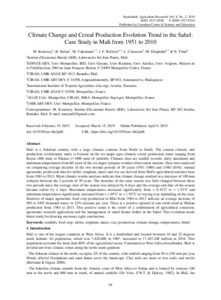| dc.contributor.author | Kouressy, M. |
| dc.contributor.author | Sultan, B. |
| dc.contributor.author | Vaksmann, M. |
| dc.contributor.author | Belières, J.F. |
| dc.contributor.author | Claessens, Lieven |
| dc.contributor.author | Dingkuhn, Michael |
| dc.contributor.author | Témé, N. |
| dc.date.accessioned | 2019-12-04T11:33:12Z |
| dc.date.available | 2019-12-04T11:33:12Z |
| dc.date.issued | 2019 |
| dc.identifier.citation | Kouressy,M., Sultan, B., Vaksmann, M., Belières, J.F., Claessens, L., Dingkuhn, M. & Témé, N. (2019). Climate change and cereal production evolution trend in the Sahel: case study in Mali from 1951 to 2010. Sustainable Agriculture Research, 8(2), 68-89. |
| dc.identifier.issn | 1927-050X |
| dc.identifier.uri | https://hdl.handle.net/20.500.12478/5553 |
| dc.description | Open Access Journal; Published online: 9 April 2019 |
| dc.description.abstract | Mali is a Sahelian country with a large climatic contrast from North to South. The current climatic and production evolutionary study is focused on the six major agro-climatic cereal production zones ranging from Kayes (400 mm) to Sikasso (>1000 mm) of rainfalls. Climatic data are rainfall records, daily maximum and minimum temperatures from 60 years of the six major synoptic weather observation stations. Data were analyzed on comparing average decades of the two normal periods of 30 years (1951-1980) and (1981-2010). Annual agronomic production data for millet, sorghum, maize and rice are derived from Mali's agricultural statistics base from 1984 to 2013. Main climatic results analyses indicate that climate change resulted in a decrease of 100 mm isohyets between the 2 periods of 30 years. The structure of the rainy season was little changed between these two periods since the average start of the season was delayed by 6 days and the average end date of the season became earlier by 4 days. Maximum temperatures increased significantly from + 0.44°C to + 1.53°C and minimum temperatures significantly increased from + 1.05°C to + 1.93°C in varying way depending on the sites. Statistics of major agronomic food crop production in Mali from 1984 to 2013 indicate an average increase of 985 to 4492 thousand tones, or 22% increase per year. There is a positive upward in saw tooth trend in Malian production from 1984 to 2013. This positive trend is the result of a combination of agricultural extension, agronomic research application and the management of small farmer holder in the Sahel. This evolution needs better study for drawing necessary right conclusions. |
| dc.format.extent | 68-89 |
| dc.language.iso | en |
| dc.rights | CC-BY-4.0 |
| dc.subject | Food Crops |
| dc.subject | Millets |
| dc.subject | Sorghum |
| dc.subject | Maize |
| dc.subject | Rice |
| dc.subject | Production |
| dc.subject | Climate Change |
| dc.subject | Temperature |
| dc.subject | Cereals |
| dc.title | Climate change and cereal production evolution trend in the Sahel: case study in Mali from 1951 to 2010 |
| dc.type | Journal Article |
| dc.description.version | Peer Review |
| cg.contributor.crp | Maize |
| cg.contributor.affiliation | Institut d'Economie Rurale, Mali |
| cg.contributor.affiliation | Université de Montpellier |
| cg.contributor.affiliation | Centre de Coopération Internationale en Recherche Agronomique pour le Développement |
| cg.contributor.affiliation | International Institute of Tropical Agriculture |
| cg.coverage.region | Africa |
| cg.coverage.region | West Africa |
| cg.coverage.country | Mali |
| cg.creator.identifier | Lieven Claessens: 0000-0003-2961-8990 |
| cg.researchtheme | NATURAL RESOURCE MANAGEMENT |
| cg.authorship.types | CGIAR and developing country institute |
| cg.iitasubject | Plant Production |
| cg.journal | Sustainable Agriculture Research |
| cg.howpublished | Formally Published |
| cg.accessibilitystatus | Open Access |
| local.dspaceid | 104643 |
| cg.targetaudience | Scientists |
| cg.identifier.doi | https://dx.doi.org/10.5539/sar.v8n2p68 |

